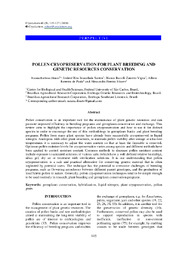Pollen cryopreservation for plant breeding and genetic resources conservation.
Pollen cryopreservation for plant breeding and genetic resources conservation.
Author(s): DINATO, N. B.; SANTOS, I. R. I.; VIGNA, B. B. Z.; PAULA, A. F. de; FAVERO, A. P.
Summary: Pollen conservation is an important tool for the maintenance of plant genetic resources and can promote improved efficiency in breeding programs and germplasm conservation and exchange. This review aims to highlight the importance of pollen cryopreservation and how to use it for distinct species in order to encourage the use of this methodology in germplasm banks and plant breeding programs. Pollen from many plant species have already been successfully cryopreserved in liquid nitrogen. Analogous with other plant structures, to maintain pollen viability after storage at ultra-low temperatures it is necessary to adjust the water content so that at least the freezable is removed. Optimum pollen moisture levels for cryopreservation varies among species and different methods have been applied to control moisture content. Common methods to decrease pollen moisture content include exposure to saturated solutions of various salts (which have a well-defined relative humidity), silica gel, dry air or treatment with vitrification solutions. It is our understanding that pollen cryopreservation is a safe and practical alternative for conserving genetic material that is often neglected by potential users. The technique has the potential to overcome challenges of breeding programs, such as flowering asynchrony between different parent genotypes, and the production of insufficient pollen in nature. Generally, pollen cryopreservation techniques tend to be simple enough to be used routinely in research, plant breeding and germplasm conservation programs.
Publication year: 2020
Types of publication: Journal article
Observation
Some of Embrapa's publications are published as ePub files. To read them, use or download one of the following free software options to your computer or mobile device. Android: Google Play Books; IOS: iBooks; Windows and Linux: Calibre.
Access other publications
Access the Agricultural Research Database (BDPA) to consult Embrapa's full library collection and records.
Visit Embrapa Bookstore to purchase books and other publications sold by Embrapa.

